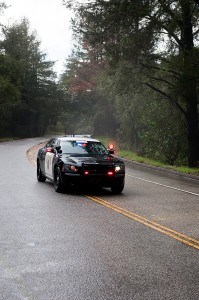In rural South Dakota, when the peaceful night is shattered by glass breaking somewhere in the house, this much people understand, Chase Strand says:
Help is not always just a 911 call away.
 For thousands of South Dakotans living far from the state’s population centers, “you get used to and understand the fact that, if you need law enforcement, it could take them 20 minutes or more to get there depending on how far they have to come,” said Strand, who ranches with his wife, Marty, east of Martin near the unincorporated town of Tuthill.
For thousands of South Dakotans living far from the state’s population centers, “you get used to and understand the fact that, if you need law enforcement, it could take them 20 minutes or more to get there depending on how far they have to come,” said Strand, who ranches with his wife, Marty, east of Martin near the unincorporated town of Tuthill.
“Fortunately,” he continued, “if you need them, it’s usually not for a serious emergency.”
In the state’s smallest towns and along its gravel roads, there is a door-left-unlocked sense of security that comes with people knowing each other well.
“We look out for each other,” Strand told the Argus Leader.
But then they have to, particularly in places where a sparse population brings with it a scarcity of law enforcement. Towns with no cops often must rely on the occasional pass-through by the sheriff or his deputies.
“I’ve got 2,000 square miles, and there’s two of us here,” said Bob Menzel, sheriff of Ziebach County in northwestern South Dakota. “We’re basically on 24 hours a day. It’s not your ideal working situation.”
Another complicating factor in rural public safety arises when the cops are committing the crimes. In the past decade in South Dakota, 49 policemen, sheriff’s deputies, highway patrolmen, 911 dispatchers and tribal officers either voluntarily relinquished their law enforcement certification or had it revoked.
Two-thirds of those decertifications came from departments with 10 or fewer officers.
“Some of it could be a lack of supervision, the lack of a command structure. It’s hard to say without looking at individual cases,” said Hughes County Sheriff Mike Leidholt, who is the current president of the National Sheriffs’ Association.
The bigger problem, he said, “is these little communities don’t have the resources to do those extensive background checks.”
The question then is this: Against a backdrop of small departments, fewer resources and the occasional problem cop, are people safer in urban South Dakota than they are in the rural areas?
The answer, it seems, is not so clear.
Canon City, Colo., Police Chief Paul Schultz, who does management training with smaller law enforcement agencies across the country, said he’s not aware of any specific data that indicates a prevalence of poorer policing in rural communities.
“If anything, I hear more often that small and rural agencies are more responsive and do a better job,” Schultz said. “There’s less crime there and more of a community policing aspect to it.”
In rural South Dakota, that’s certainly true in bucolic settings such as Armour, Alexandria and the countryside around them in Douglas and Hanson counties.
In the previous year ending this past June 30, those two counties could muster just one charge for aggravated assault and one charge for disorderly conduct between them. Theft and burglary were virtually nonexistent. The two counties combined averaged just over one DUI charge a month.
“In Sioux Falls, you have law enforcement that investigates armed robberies and does DUI enforcement on a regular basis,” former Spink County deputy sheriff Heath Shottenkirk said from his home in Redfield. “In Spink County, you get kids stealing tomatoes, or the neighbor’s dog over in Joe Blow’s garden.”
But not everywhere. Bennett County in southwestern South Dakota has the highest per-capita crime rate in the state, though its population virtually mirrors that in Douglas and Hanson counties.
Sandwiched between the Pine Ridge and Rosebud reservations, Bennett County charged out aggravated assault at 11 times the rate of what it was in Douglas and Hanson counties combined in the year ending last June. Disorderly conduct charges were 43 times higher. Burglary, simple assault, theft, DUI, drugs – all higher.
“Martin is not your average small city in South Dakota,” explained the town’s police chief, Julio Medeiros.
In a pattern that plays out similarly in other communities with significant minority populations, Martin and Bennett counties see a lot of sexual and domestic assault, beatings and other violence.
In most of those cases, the victim and perpetrator are from the same race, Medeiros said, whether white on white or tribal on tribal. Where the crimes cross racial lines then is when they involve property, the police chief said, such as grocery store thefts or people breaking into houses.
There was so much of that going on when he came to Martin in July 2011 that Medeiros found a community gripped in fear.
“The clerk of courts said to me one day, ‘Before you got here, I was afraid to walk around here at night,’ ” Medeiros said. “Now you don’t see hundreds of derelicts running around in the streets. We had stabbings in the middle of the road at 9 o’clock at night in the middle of the summer. Women were being beaten crossing the street.”
An East Coast native who retired from a 23-year career with a police department in suburban Providence, R.I., because of issues with that state’s pension plan, Medeiros said one of his first moves as Martin’s police chief was to push his department from two to five full-time officers.
They saturated Martin’s streets with patrolmen, he said. They went after the drug dealers and landed 13 federal indictments in one major drug case alone.
The citizens applauded them, Medeiros said. And some began to grumble that community policing in Martin was being sacrificed by overzealous cops.
“We put people in jail, and that’s good,” the police chief said. “But obviously, unfortunately, it’s a different type of policing than in bigger cities. People don’t necessarily want law enforcement out here.
“The moral of the story is, we personally have to win the community. And a lot of times, what we see with people is, when they need you, they want you. But more often there is resentment. I’ll hear it from the ranchers living outside of town. You hear all the time, ‘Why do we need all these officers? Why don’t we have one law enforcement agency for everybody?”‘
Like many smaller South Dakota communities near reservations – Winner, Wagner, McLaughlin and Martin among others – public safety is complicated by the checkerboard nature of tribal islands within county borders. Near Martin, for example, there are two tribal housing clusters – Sunrise at the southeast edge of town and North at the north end – where neither Medeiros’ officers nor Bennett County deputies have jurisdiction.
A burglar can break into a house in town in Martin, race across the road to tribal housing, and his deputies can’t touch them, Bennett County Sheriff Luke Hamar said. He told a story about sitting in his patrol car one night and witnessing a fight unfolding in nearby North Housing. He watched as a man got in his vehicle and tried to run others down.
“I didn’t want to see anyone die because I didn’t do something,” Hamar said. “So I turned on my flashers so he knew I was there. I had to do something. They saw the lights and simmered down.”
He calls that protecting the public. But others in Martin, especially among tribal residents, say any sense of security they might feel is diminished by what they see as harassing and intimidating behavior by law enforcement.
Sitting in the local Subway restaurant in Martin, Carol Iron Horse Herrera, Amanda Takes War Bonnett and Angie Sam describe a situation on the ninth of each month when stores in town open late to serve customers whose electronic food stamp benefits are replenished.
Families show up just before midnight to the stores because they are hungry, the three women said. The police show up to serve warrants and otherwise stop tribal people for what the women called trivial issues.
“The cops follow the Native drivers around as opposed to the non-Native drivers,” Sam said. “You watch them; they patrol between town and Sunshine housing, and if they can find a reason to pull you over, a headlight out or a blinker, they will.”
It’s called profiling, Iron Horse Herrera said. “But we’re used to it,” she said. “It’s been happening for years. It happens in all the border towns.”
Like many smaller South Dakota communities near reservations – Winner, Wagner, McLaughlin and Martin among others – public safety is complicated by the checkerboard nature of tribal islands within county borders. Near Martin, for example, there are two tribal housing clusters – Sunrise at the southeast edge of town and North at the north end – where neither Medeiros’ officers nor Bennett County deputies have jurisdiction.
A burglar can break into a house in town in Martin, race across the road to tribal housing, and his deputies can’t touch them, Bennett County Sheriff Luke Hamar said. He told a story about sitting in his patrol car one night and witnessing a fight unfolding in nearby North Housing. He watched as a man got in his vehicle and tried to run others down.
“I didn’t want to see anyone die because I didn’t do something,” Hamar said. “So I turned on my flashers so he knew I was there. I had to do something. They saw the lights and simmered down.”
He calls that protecting the public. But others in Martin, especially among tribal residents, say any sense of security they might feel is diminished by what they see as harassing and intimidating behavior by law enforcement.
Sitting in the local Subway restaurant in Martin, Carol Iron Horse Herrera, Amanda Takes War Bonnett and Angie Sam describe a situation on the ninth of each month when stores in town open late to serve customers whose electronic food stamp benefits are replenished.
Families show up just before midnight to the stores because they are hungry, the three women said. The police show up to serve warrants and otherwise stop tribal people for what the women called trivial issues.
“The cops follow the Native drivers around as opposed to the non-Native drivers,” Sam said. “You watch them; they patrol between town and Sunshine housing, and if they can find a reason to pull you over, a headlight out or a blinker, they will.”
It’s called profiling, Iron Horse Herrera said. “But we’re used to it,” she said. “It’s been happening for years. It happens in all the border towns.”
Medeiros and Hamar insist that isn’t true but acknowledge the fragile relationship between the races in their community. That’s where the value of community policing comes in, they say.
“Just saying ‘Hi’ to someone when you’re off duty, saying ‘Hi’ and asking them how they’re doing, Indian, white, whoever. You can’t believe how far that will go,” Hamar said.
In a way, these discussions happen in one form or another in most small towns and rural South Dakota. If it’s not about race, it’s about whom law enforcement is or isn’t stopping on the streets, whom they’re arresting, why they’re arresting them and how that affects lives and business in that community.
Shottenkirk, the former deputy in Spink County who worked for the sheriff’s department there from 1997 to 2005, has a story to illustrate that. One summer, he said, another deputy he worked with arrested a 14-year-old boy at 3 in the morning for “trying to break into the pool and being out raising hell.”
The deputy brought the teen to the sheriff’s office and called his parents. When Mom and Dad arrived, they started yelling at the deputy, said Shottenkirk, who remembered that “the deputy looked right at them and said, ‘Maybe if you were better parents, you wouldn’t be down here dealing with this.’ ”
Shottenkirk stared at the floor and thought, “Oh, boy.”
It wasn’t long after the family left that the sheriff, awakened from a deep sleep by a call from angry parents, telephoned the office and advised his deputy on what was going to happen in the future.
“That’s how small-town America is different from Sioux Falls,” Shottenkirk said.
It has to be different. In Sioux Falls, a policeman can arrest a drunken driver and take them to jail in a matter of minutes. In the Gregory County community of Burke in south-central South Dakota, Police Chief Dennis Erickson has to weigh the wisdom of arresting a motorist who is right at the blood-alcohol limit versus the hour it will take him to transport that driver to jail in nearby Winner, leaving his own town unprotected.
“I’ve given people rides home who are higher” than the legal limit, Erickson said.
Other small-town law enforcement officers have done the same. Attorney General Marty Jackley acknowledged that such discretion has to be part of rural law enforcement, especially when time spent appearing in court for suppression hearings and trials, writing search warrants for DUI blood draws – even transporting drunks long distances to jail – means those small towns are left unprotected.
“We trust our law enforcement officers to make those decisions and try to best protect us,” Jackley said.
A police officer on the way to Winner is just that many more minutes removed when the quiet night is shattered by glass breaking in someone’s house. Fortunately, that doesn’t happen very often in rural South Dakota. And if it does, well, public safety isn’t always exercised with a badge.
“In Conde or in Mellette here in Spink County, or in any small town across the state, I bet it would scare you to know that there is a gun in 90 to 95 percent of the houses, and people in those houses who know how to use the gun,” Shottenkirk said.
“If you’re Joe Dirtbag, and you break in the front door, you’re going to get capped. I think that, more than anything, keeps people from doing stupid stuff in rural South Dakota.”
Was this article valuable?
Here are more articles you may enjoy.

 Tesla Showroom Strikes, Vandalism Sparked by Fury Against Musk
Tesla Showroom Strikes, Vandalism Sparked by Fury Against Musk  An Unusually Active Hurricane Season Is in Store for the Atlantic
An Unusually Active Hurricane Season Is in Store for the Atlantic  California Man Wins $50M in Lawsuit Over Burns From Starbucks Tea
California Man Wins $50M in Lawsuit Over Burns From Starbucks Tea  Bankrupt 23andMe’s DNA Data Gets Sale Nod as Concerns Linger
Bankrupt 23andMe’s DNA Data Gets Sale Nod as Concerns Linger 